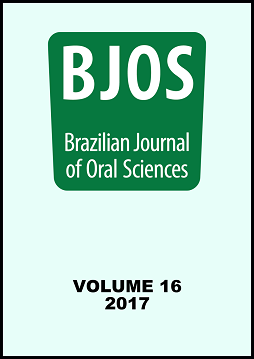Abstract
Aim: To determine factors that may affect the time of discharge from hospital in patients who underwent maxillofacial trauma. Methods: The sample included 115 patients seen at a public hospital in Brazil, to whom surgical maxillofacial treatment was delivered. Data were obtained from patients’ medical records and then followed by a statistical analysis using a 5% significance level. Results: The location of fractures and other clinical features such as the presence of edema and ecchymosis were found to be significantly associated with increased time of discharge from hospital (P < 0.05). When data were modeled using a GML approach, male gender was associated with a lower likelihood of prolonged hospital discharge (OR = 0.84; 95% CI: 0.72–0.98; P < 0.05), while the presence of edema was associated with greater time of hospital discharge (OR = 1.30; 95% CI: 1.14–1.49; P < 0.001). No significant association with age, etiology of trauma, and number of fractures was observed (P > 0.05). Conclusion: Female gender was associated with greater time of hospital discharge, and further concerns should be addressed to the management of lesions following maxillofacial trauma surgical interventions.References
Al-Dajani M, Quinonez C, Macpherson AK, Clokie C, Azarpazhooh A. Epidemiology of Maxillofacial Injuries in Ontario, Canada. J Oral Maxillofac Surg. 2015 Apr;73(4):693.e1-9. doi: 10.1016/j.joms.2014.12.001.
Salentijn EG, Collin JD, Boffano P, Forouzanfar T. A ten year analysis of the traumatic maxillofacial and brain injury patient in Amsterdam: complications and treatment. J Craniomaxillofac Surg. 2014 Dec;42(8):1717-22. doi: 10.1016/j.jcms.2014.06.005.
Leles JLR, Santos EJ, Jorge FD, Silva ET, Leles CR. Risk factors for maxillofacial injuries in a Brazilian emergency hospital sample. J Appl Oral Sci. 2010 Jan-Feb;18(1):23-9.
Allareddy V, Allareddy V, Nalliah RP. Epidemiology of facial fracture injuries. J Oral Maxillofac Surg. 2011 Oct;69(10):2613-8. doi: 10.1016/j.joms.2011.02.057.
Perry M. Maxillofacial trauma--developments, innovations and controversies. Injury. 2009 Dec;40(12):1252-9. doi: 10.1016/j.injury.2008.12.015
Boffano P, Kommers SC, Karagozoglu KH, Forouzanfar T. Aetiology of maxillofacial fractures: a review of published studies during the last 30 years. Br J Oral Maxillofac Surg. 2014 Dec;52(10):901-6. doi: 10.1016/j.bjoms.2014.08.007.
Motamedi MHK, Dadgar E, Ebrahimi A, MD, Shirani G, Haghighat A, Jamalpour MR. Pattern of maxillofacial fractures: a 5-year analysis of 8,818 patients. J Trauma Acute Care Surg. 2014 Oct;77(4):630-4. doi: 10.1097/TA.0000000000000369.
Kostakis G, Stathopoulos P, Dais P, Gkinis G, Igoumenakis D, Mezitis M, et al. An epidemiologic analysis of 1,142 maxillofacial fractures and concomitant injuries. Oral Surg Oral Med Oral Pathol Oral Radiol. 2012 Nov;114(5 Suppl):S69-73. doi: 10.1016/j.tripleo.2011.08.029.
Allareddy V, Itty A, Maiorini E, Lee MK, Rampa S, Allareddy V, et al. Emergency department visits with facial fractures among children and adolescents: an analysis of profile and predictors of causes of injuries. J Oral Maxillofac Surg. 2014 Sep;72(9):1756-65. doi: 10.1016/j.joms.2014.03.015.
Arangio P, Vellone V, Torre U, Calafati V, Capriotti M, Cascone P. Maxillofacial fractures in the province of Latina, Lazio, Italy: review of 400 injuries and 83 cases. J Craniomaxillofac Surg. 2014 Jul;42(5):583-7. doi: 10.1016/j.jcms.2013.07.030.
Roccia F, Bianchi F, Zavattero E, Tanteri G, Ramieri G. Characteristics of maxillofacial trauma in females: a retrospective analysis of 367 patients. J Craniomaxillofac Surg. 2010 Jun;38(4):314-9. doi: 10.1016/j.jcms.2009.10.002
Nogami S, Yamauchi K, Yamashita T, Kataoka Y, Hirayama B, Tanaka K, et al. Elderly patients with maxillofacial trauma: study of mandibular condyle fractures. Dent Traumatol. 2015 Feb;31(1):73-6. doi: 10.1111/edt.12129.
Lin S, Levin L, Goldman S, Peled M. Dento-alveolar and maxillofacial injuries: a 5-year multi-center study. Part 1: general VS facial and trauma dental. Dent Traumatol. 2008 Feb;24(1):53-5.
doi: 10.1111/j.1600-9657.2006.00510.x.
Van Hout WM, Van Cann EM, Abbink JH, Koole R. An epidemiological study of maxillofacial fractures requiring surgical treatment at a tertiary trauma centre between 2005 and 2010. Br J Oral Maxillofac Surg. 2013 Jul;51(5):416-20. doi: 10.1016/j.bjoms.2012.11.002.
Yamamoto K, Matsusue Y, Murakami K, Horita S, Sugiura T, Kirita T. Maxillofacial fractures in older Patients. J Oral Maxillofac Surg. 2011 Aug;69(8):2204-10. doi: 10.1016/j.joms.2011.02.115.
Brasileiro BF, Passeri LA. Epidemiological analysis of maxillofacial fractures in Brazil: a 5-year prospective study. Oral Surg Oral Med Oral Pathol Oral Radiol Endod. 2006 Jul;102(1):28-34.
Mijiti A, Ling W, Tuerdi M, Maimaiti A, Tuerxun J, Tao YZ, et al. Epidemiological analysis of maxillofacial fractures treated at a university hospital, Xinjian, China: a 5-year retrospective study. J Craniomaxillofac Surg. 2014 Apr;42(3):227-33. doi: 10.1016/j.jcms.2013.05.005
Jensen J, Pedersen-Sindet S, Christensen L. Rigid xation in reconstruction of craniofacial fractures. J Oral Maxillofac Surg. 1992 Jun;50(6):550-4.
The Brazilian Journal of Oral Sciences uses the Creative Commons license (CC), thus preserving the integrity of the articles in an open access environment.

